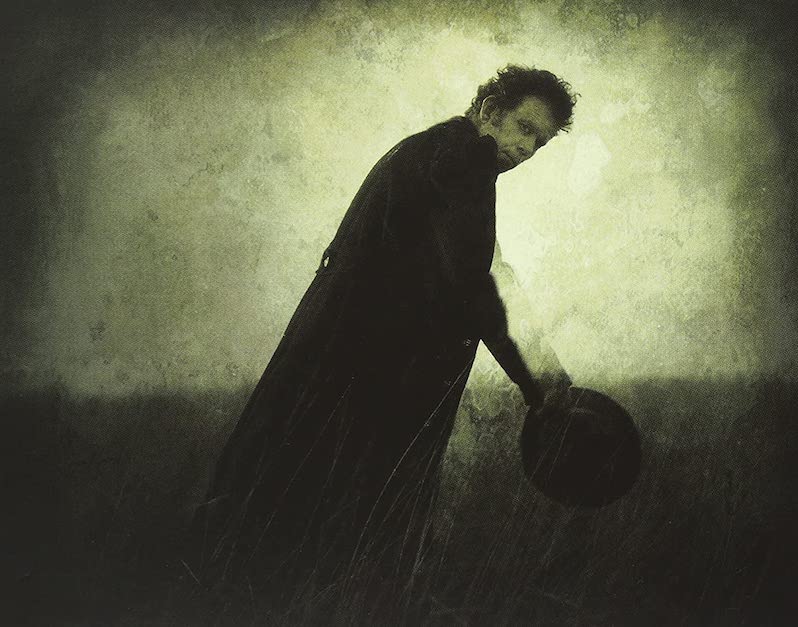In Tom Waits’ “What’s He Building?”, it’s not clear who the monster is

Tom Waits is a storyteller. As a songwriter, it’s one of his greatest talents, the world of his extensive catalog filled with rogues and miscreants, oddballs and outcasts—people you may or may not relate to, but you damn sure want to know what happens to them, where they came from and how they ended up in a lonely room full of junk, or on a boat, or perhaps through the looking glass. It’s easy to think of Waits himself as one of the characters in his own songs, in part because of his gruff bark and fascination with the absurd, and in part because, well, he’s a notorious liar. Not for diabolical reasons mind you, it’s just part and parcel of his uncanny skill for spinning a yarn. “My father was a knife thrower,” he said in a 2002 GQ interview. “And my mother was a trapeze artist. So we were a showbiz family.”
It’s important to remember that when going into “What’s He Building?”, the deeply unsettling spoken-word centerpiece of Waits’ 1999 album Mule Variations. It’s not a true story—not exactly. There are truths within it, and Waits has certainly written songs that are based in real (sometimes tragic) circumstances, but he’s not a biographer or a journalist. Tom Waits is an architect of unseen worlds, ones not too distant from our own, but just slightly more off.
We actually don’t know much about the central figure in “What’s He Building?” He’s a composite of his neighbors’ observations and speculation, the subject of busybodies’ gossip and unearned prejudices. The blue glow of a television screen emanates from his dark windows, his lawn is dying, there may or may not be poison under his sink. Nobody really knows for sure, but there’s just something not right about what’s happening down the street, in this house, where this unnamed loner, perpetrator of unseen deeds, lives.
The track, inspired by the “word jazz” of Ken Nordine, isn’t so much a song as a miniature radio play, crafted not with melody but static-laden drones and sound effects beneath Waits’ grumbled, one-sided narration. Squeaks, clinks, honks, crashes and rustles erupt beneath Waits’ ominous, darkly humorous reading of the neighbors’ fears and suspicions: “He’s hiding something from the rest of us“; “I heard he has an ex-wife someplace called Mayor’s Income, Tennessee“; “I swear to god I heard someone moaning low…” At one point Waits even declares, “You won’t believe what Mr. Stitches saw.” And I’d like to just take a moment to say: Mr. Stitches?!
The entirety of the track’s three minutes is filled with an eerie sense of foreboding. And there’s definitely something fucked up happening here. The He that we hear so much about in this song—without learning a single thing about him—is building something. A reanimated corpse? A murder room? Some other kind of sinister mechanism for spreading mayhem among his neighbors, perhaps. But it’s not until the end of the song that Waits reveals the true menace of the song, growling, “We have a right to know.”
The monster, as is often the case, is us. “We seem compelled to perceive our neighbors through the keyhole,” Waits says in the book Wild Years: The Music and Myth of Tom Waits. “You see that drives this yellow station wagon without a windshield, and he has chickens in the backyard, and doesn’t get home ’til 3:00 A.M., and he says he’s from Florida but the license says Indiana… so, you know, ‘I don’t trust him.'”
The song strangely took on a second life more recently as an ironic backing for TikTok videos depicting the manufacture of makeshift bongs (but really what song hasn’t become a TikTok meme yet?). Though that doesn’t necessarily remove the sense of morbid curiosity and menace that the track harbors. It’s really just a question of which person on either side of that property line is the truly dangerous one. This isn’t really about what he’s building, but why it seems to bother us so much.
Support our Site—Subscribe to Our Patreon: Become one of our monthly patrons and help support an independent media resource while gaining access to exclusive content, shirts, playlists, mixtapes and more.
Jeff Terich is the founder and editor of Treble. He's been writing about music for 20 years and has been published at American Songwriter, Bandcamp Daily, Reverb, Spin, Stereogum, uDiscoverMusic, VinylMePlease and some others that he's forgetting right now. He's still not tired of it.

